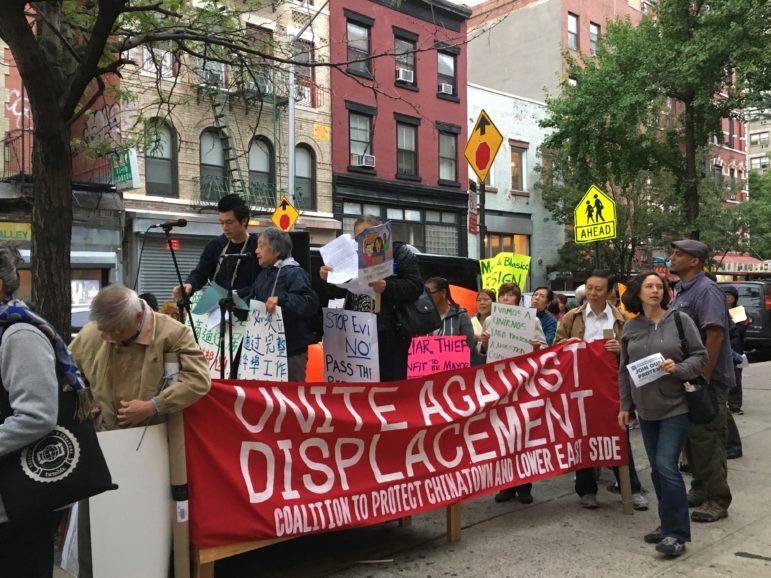
Janaki Chadha
Protesters outside the meeting chanted in English, Spanish and Cantonese.
At a Community Board 3 Land Use Committee meeting Thursday night to discuss plans to rezone Chinatown, neighborhood residents expressed confusion and frustration over the city’s treatment of their community-drafted rezoning proposal.
A collaborative effort launched in 2008 by the Chinatown Working Group (CWG), an organization formed to help preserve the affordability of the neighborhood, this proposal aimed to create a “Special District” spanning Chinatown and the Lower East Side and put in place zoning protections that would benefit immigrant, working class and public housing residents over a sizable portion of Lower Manhattan.
The Department of City Planning (DCP), which rejected the full CWG proposal in February 2015, said the plan is too expansive, and called for the creation of a narrower proposal focused more specifically on Chinatown—but community advocates have not backed down, arguing that the affordability crisis in the area requires prompt, widespread action.
On Thursday, the Coalition to Protect Chinatown and the Lower East Side, an association of community organizations, held a protest outside the committee meeting. A group of a few dozen neighborhood residents and activists gathered with signs in English, Spanish and Chinese, and chanted, “Chinatown – not for sale! Lower East Side – not for sale!”
In a statement to DCP the coalition wrote, “After years of hard work and input by tens of thousands of community members, DCP is dismissing CWG as nothing but advisory. Worst of all, this carving up of our community is continuing a legacy of discrimination and racist exclusion of the Lower East Side, pitting people of color against each other to fight for crumbs.”
Thursday’s meeting included a presentation by representatives from DCP on what the path towards a Chinatown neighborhood rezoning plan might look like, emphasizing the many opportunities for community engagement that will be a part of the process.
But many community residents in the audience weren’t convinced. James Rodriguez, of the neighborhood housing and preservation organization “Good Old Lower East Side” (GOLES), said the meeting felt disingenuous.
“A plan has already been developed, that has gone through numerous, numerous meetings over nearly a decade, and now we’re talking about beginning a public engagement process,” he said. “That doesn’t make a lot of sense to me and it feels a little absurd, to be honest.”
Several attendees raised questions about DCP’s criteria for deciding the original CWG proposal was not feasible. Joel Kolkmann of the department’s Manhattan office said the geographic scope of the plan was simply too large to implement, and proposals need to be targeted on a neighborhood basis.
Edith Hsu-Chen, director of DCP’s Manhattan office, emphasized that focusing on Chinatown specifically now doesn’t mean issues in other neighborhoods won’t be addressed in the future, but simply that it’s best for neighborhoods to be addressed individually.
“We want to make sure that we have a plan that is implementable,” she said. “Let’s focus on what we can focus on and not disregard the rest, but focus on something we can deliver.”
But for some, a plan that leaves out the Lower East Side and other areas included in CWG’s proposal is difficult to accept.
“There’s no point in rezoning Chinatown if you don’t protect everything else,” said committee member Cathy Dang. Fellow member Damaris Reyes agreed, saying, “I think we have been clear all along that we do not accept moving any part of this plan without looking at and including the rest of it.”
For Reyes, the situation is urgent, as the neighborhoods in question are changing rapidly. “We don’t have any time to waste,” she said. “Once those buildings go up, and that train is moving, we’re done. So this is the opportunity where the city can show us that they’re going to meet us part of the way.”
City Limits’ reporting on housing and development is supported by the Charles H. Revson Foundation and the New York Community Trust.









2 thoughts on “Chinatown Groups Still Hope City Will Take Up Their Rezoning Plan”
Pingback: Bowery Tenants Hit the Streets Again to Protest Dr. Jay’s Owner Joseph Betesh
Pingback: Community Plans For Bushwick, Worries It Will Not Matter - BKLYNER